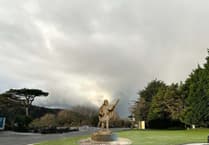There is still something about treasure hunts that excite people even if their popularity has waned over the years.
I remember often taking part in treasure hunts as a kid, racing round random country lanes in the middle of nowhere looking for cryptic clues which would always end up in the participants tucking into a meal at the end – usually something like chicken in a basket.
In the early 1980s, there was treasure hunt fever when Cadbury’s announced it had hidden certificates across the UK which would entitle the find to a golden egg. One of them was hidden in the Isle of Man and we even discussed it at school.
The certificate was eventually found at Maughold churchyard and the recipient received a 22-carat egg adorned with a Manx cat, Laxey's wheel, Fairy Bridge and pink enamelled fairies.
More recently, there was the Golden Queenies treasure Hunt as part of the Queenie Festival in 2012 with the treasure eventually found at Mortuary Beach at Port Erin.
The advancement of technology has maybe blunted the romance of the treasure hunt these days with the use the internet, mobile phones and AI making solving clues easier.
But, imagine if Visit Isle of Man announced it had brought onboard JK Rowling or Richard Osman to write a short story with clues to solving a real life treasure hunt on the Isle of Man.
.jpeg?trim=398,0,1380,0&width=752&height=500&crop=752:500)
That is exactly what happened in 1930 when island tourism bosses commissioned the great Agatha Christie to write a short story with clues to the treasure hunt.
She was paid a paltry £60 – still only the equivalent of a few thousand pounds today – to write the story entitled ‘Manx Gold’.
I am a bit of a fan of golden age detective fiction and I hadn’t heard about this story until I listened to a podcast which mentioned it.
Other than the Isle of Man Post Office creating commemorative stamps in 2003 in Christie’s honour, it has become somewhat forgotten.
Back in 1930, the Isle of Man was a popular holiday destination in the summer although its halcyon days were starting to wane.
The tourist board hoped the treasure hunt would get people out and around the island, visiting some of its scenic highlights.
Within the short-story, Christie blended both written and visual clues to help readers locate one of four snuff boxes that could be exchanged for £100 at the tourism office – worth several thousand pounds in today’s money. There were four in total.

Advertisements promoting the Christie treasure hunt began appearing in newspapers across the UK and those interested would receive a free guide and road map.
Manx Gold was then published in the Daily Dispatch, a Manchester newspaper, in five instalments from the May 23-28,1930.
On the island, the summer tourism promotional pamphlet ‘June in Douglas’ was distributed throughout the island and also contained the story. Sadly, island residents could not claim any of the prizes.
The story of Manx Gold is pretty simple which none of Christie’s usual sinister twists and turns. She embraced Manx culture using classic Manx names. The main characters are Juan and Fenella who are first cousins and romantically involved – this was a century ago after all - and inherit the estate of their Uncle Myles.
Included in this estate are a series of clues that will lead them to their great grandfather’s fortune made from smuggling.
With a competing relative and a murder thrown in, the lead characters essential narrate the treasure hunt to the readers.

As well as the clues within the narrative of the story, separately published clues also gave readers further help to find the hidden snuff boxes.
The snuff boxes were located at Derby Fort on St Michael’s Isle at Langness, a bench on Peel Hill overlooking Peel Castle, a gully 85 close to Meayll Circle on Mull Hill, near Cregneash and in an ivy covered wall near a kiosk within Mooragh Park.
Among all the dozens of incredible novels and short stories written by the prolific Christie, Manx Gold seemed to get lost in the mists (or Manannan’s Cloak) of time.
However, in recent years the book has been published in a collection of short stories in book and ebook form.
It is not clear how successful Christie’s story was in boosting tourism on the island but it seems like it was a lot of fun at the time.
.jpeg?width=752&height=500&crop=752:500)



